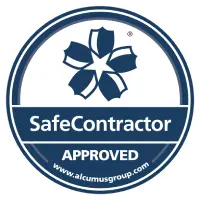Planned Preventative Maintenance (PPM) and Reactive Maintenance in London
Limit office disruptions and equipment faults with our tailored maintenance services.
What is Planned Preventative Maintenance (PPM)?
Planned Preventative Maintenance (PPM), often referred to as planned maintenance or scheduled maintenance, is an essential strategy employed by successful companies worldwide. It represents a proactive approach where maintenance tasks are scheduled and performed with foresight, to prevent potential equipment failures and ensure seamless business operations.
The essence of a Planned Preventative Maintenance plan is its focus on averting problems before they arise. Instead of reacting to equipment breakdowns, a well-designed PPM strategy ensures companies have a process in place that inspects, detects, and corrects minor issues early, preventing them from escalating into costly repairs or replacements.
Adopting a preventative maintenance plan brings with it a host of benefits for companies. It aids in maximizing equipment longevity, reducing unplanned downtime, and enhancing overall operational efficiency. Moreover, it leads to substantial cost savings in the long run by minimizing expensive emergency repairs and improving energy efficiency.
Planned maintenance, when done right, also contributes to a safer working environment. By ensuring that equipment functions optimally, it reduces the risk of accidents caused by malfunctioning machinery.
Planned Preventative Maintenance (PPM) is not just a strategy; it’s a culture of preparedness and prevention that promotes efficiency and productivity. It’s an investment that pays off handsomely by helping your company stay one step ahead in maintaining operational reliability and business continuity.
PPM can be broken down into several categories, including:
Time-Based Maintenance (TBM): This approach schedules maintenance activities based on a predetermined timeline, such as every week, month, or year. It’s especially effective for equipment that tends to wear out over a predictable timeframe.
Usage-Based Maintenance (UBM): In this type of PPM, maintenance tasks are scheduled based on the usage of the equipment. This might involve conducting maintenance after a certain number of operational hours, cycles, or output.
Predictive Maintenance (PdM): This more sophisticated approach uses sensors and advanced analytics to monitor equipment in real-time, predict when a failure might occur, and schedule maintenance just in time to prevent the predicted failure. PdM can often result in cost savings, as it avoids unnecessary maintenance while still preventing unexpected failures.
Prescriptive Maintenance: This is an advanced type of predictive maintenance that not only predicts when an equipment failure might occur but also provides recommendations on actions to prevent the failure. This approach typically relies on artificial intelligence and machine learning to analyze data and generate prescriptive advice.
Preventative Inspection: This is a basic form of PPM where equipment is regularly inspected for potential issues. The goal is to catch problems while they are still minor and before they lead to equipment failure.
Reliability Centered Maintenance (RCM): This approach focuses on the function of the system as a whole rather than individual pieces of equipment. Maintenance tasks are prioritized based on how critical each function is to the overall system, aiming to increase the reliability and performance of the entire system.
Planned Preventative Maintenance (PPM) Inclusions
In cooperation with our talented partners, we offer planned maintenance services to ensure all your building’s services are functioning properly.
- Boiler Maintenance
- Air Conditioning Installations and Maintenance
- Alarms and CCTV Systems Installations and Maintenance Contracts
- Tap Temperatures
- Water Sampling
- Weekly Fire Bell Tests
- Fire extinguisher contracts
- Fire Evacuations
- Lamp Maintenance
- Emergency Lighting Services
- Electrical Facilities Management including Portable Appliance Testing
- Fixed Wire Electrical Testing
- Health and Safety, incorporating Office and Fire Risk Assessments
What is Reactive Maintenance?
Reactive Maintenance, often synonymous with ‘repair in reaction to a problem’, plays a pivotal role in many companies’ overall maintenance strategies. Reactive maintenance services spring into action when an equipment failure has already occurred, working swiftly to restore normalcy and minimize downtime.
Under the umbrella of reactive maintenance, there are four common types, each serving specific scenarios:
Breakdown Maintenance: This involves letting the machinery work until it breaks down, and only then is maintenance performed. Although this approach might sound risky, it’s actually an economical choice for non-critical equipment that doesn’t affect operations significantly when it fails.
Run-to-failure Maintenance: Similar to breakdown maintenance, run-to-failure means the equipment runs until it can’t operate any longer. The difference is that in run-to-failure maintenance, this eventuality is anticipated, and preparations are made in advance for a swift repair or replacement when the failure occurs.
Corrective Maintenance: This encompasses actions carried out after a fault is detected. It’s aimed at restoring an asset to a condition in which it can perform its intended function.
Emergency Maintenance: As the name suggests, this type involves unexpected problems that need immediate attention to prevent catastrophic results. This could mean repairing equipment that, if left unattended, could lead to safety hazards or significant operational disruption.
While reactive maintenance may have a reputation of being less desirable than its preventative counterpart, it’s often an effective strategy for certain equipment. Especially for assets where breakdowns aren’t frequent or don’t affect the overall productivity substantially. By understanding the intricacies of different types of reactive maintenance, businesses can smartly integrate it into their broader maintenance plan, achieving a balanced and cost-effective maintenance strategy.
24 Hour Reactive Maintenance Inclusions
Reactive maintenance offers office buildings a safety net in the case anything breaks down or requires urgent repair. With our 24-hour service, you can be sure that we’ll be there to help if anything goes wrong.
- Carpentry
- Decorating
- Electrics
- Security
- Plumbing
- General Property Maintenance
What is a Planned Preventative Maintenance and Reactive Maintenance Strategy?
Planned Preventative and Reactive Maintenance is a comprehensive maintenance strategy that involves both preventive planned maintenance and corrective/reactive maintenance for buildings in London.
As discussed, Planned Preventative Maintenance (PPM), is a proactive approach to planned building maintenance that involves regularly scheduled inspections, repairs, and replacements of building components and systems to prevent breakdowns and reduce the likelihood of unexpected downtime.
In contrast, Reactive Maintenance is performed in response to unexpected failures or issues that require immediate attention. This approach focuses on fixing problems as they arise rather than preventing them in the first place.
The benefits of employing a blended strategy such as this includes:
Resource Optimization: This strategy ensures that resources are used judiciously. The planned aspect allows for orderly scheduling of maintenance staff and parts, while the reactive element helps handle unexpected breakdowns effectively.
Cost Efficiency: A blended approach balances the high immediate costs of reactive maintenance with the long-term investment in planned preventative maintenance, striking a cost-effective equilibrium.
Reduced Downtime: Planned maintenance helps prevent unexpected failures, and reactive maintenance ensures quick fixes when equipment breaks down. This combined strategy minimizes overall downtime.
Prolonged Equipment Lifespan: Regular preventative maintenance can extend the life of your equipment, while timely reactive maintenance ensures that sudden breakdowns are quickly addressed, preventing further damage.
Improved Safety: Regular checks and repairs as part of a preventative maintenance plan can help prevent accidents caused by equipment failure. Likewise, reactive maintenance addresses any immediate safety issues caused by breakdowns.
Increased Productivity: With less downtime and more efficient equipment, productivity can increase. A well-maintained machine generally runs better and faster.
Flexibility: A blended approach allows companies to adjust their maintenance focus as needed, based on equipment criticality, age, usage patterns, and other factors. This adaptability is invaluable in managing a diverse set of assets.
Predictability: While planned maintenance provides a predictable maintenance schedule aiding in strategic planning, reactive maintenance allows companies to prepare for and manage unpredicted equipment failures.
Preservation of Capital Assets: Regular maintenance under this strategy helps ensure the functionality and efficiency of expensive equipment, safeguarding your company’s capital assets.
By incorporating both planned and reactive maintenance into a unified strategy, businesses can enjoy these benefits and establish an effective, efficient, and flexible maintenance regimen.
Pick and Mix
Maintenance Service
Why should you have to pay for something you don’t need? We agree that you shouldn’t, and that’s why we tailor all our maintenance packages around your unique needs. Property maintenance is an important part of ensuring your building’s functionality and safety.
Without it, things can misfunction and break down, disrupting your building and its occupants. The FCFM team can maintain your essential services, keeping your facility safe and your staff uninterrupted!
Why should you have to pay for something you don’t need? We agree that you shouldn’t, and that’s why we tailor all our maintenance packages around your unique needs. Property maintenance is an important part of ensuring your building’s functionality and safety.
Without it, things can malfunction and break down, disrupting your building and its occupants. The FCFM team can maintain your essential services, keeping your facility safe and your staff uninterrupted!

Frequently Asked
Questions
PPM in maintenance stands for Planned Preventative Maintenance. It’s a proactive maintenance strategy that involves scheduling regular inspection and maintenance activities to prevent equipment failures and breakdowns.
Planned Preventative Maintenance (PPM) is a proactive and scheduled maintenance approach. It involves performing regular maintenance tasks to detect and address potential issues before they escalate into serious problems. The goal is to maintain optimal functionality of equipment, extend its life, and prevent unexpected equipment downtime.
Creating a preventive maintenance plan involves several steps: First, you need to inventory your equipment and prioritize items based on factors like age, usage, and criticality to your operations. Next, establish a schedule for each piece of equipment based on the manufacturer’s recommendations, equipment history, and usage patterns. Then, identify the tasks that need to be performed, such as cleaning, inspection, or parts replacement. Finally, implement the plan, monitor its effectiveness, and adjust as needed over time.
Reactive maintenance, also known as breakdown maintenance, involves repairing and maintaining equipment after it has broken down or exhibited a problem. It’s a strategy that waits for faults to occur before performing maintenance services.
Preventive maintenance and reactive maintenance each have their benefits and are best suited to different situations. Preventive maintenance can minimize downtime and extend the life of equipment, making it a good choice for critical assets. Reactive maintenance, on the other hand, can be more cost-effective for non-critical assets or those with a high MTBF (Mean Time Between Failures). Most businesses find that a combination of both strategies works best.
A planned preventative maintenance and reactive maintenance strategy is a balanced approach to equipment maintenance that uses elements of both strategies. It involves scheduling regular maintenance tasks to keep equipment in good working order (PPM) while also being prepared to quickly fix any breakdowns that do occur (reactive). This strategy aims to maximize operational efficiency and cost-effectiveness by using the most suitable maintenance approach for each piece of equipment.
Why First Class Facilities Management?

Experienced
and Trusted
Our team have decades of industry experience and are trusted by small and large brands. We’ll be with you every step of the way!

Certifications
At FCFM, we have a Safe Contractor Accreditation, and our PAT Tester is a City and Guilds Qualified Electrician.

Tailored
Approach
Your unique needs determine the frequency and scope of our services. Whether you need regular check-ups of your safety features or urgent assistance with a plumbing emergency, we can assist.

Case Study
We work collaboratively to deliver innovative solutions and premium services. Learn more about our recent office and facilities management projects here.
Looking for an Experienced Team to Assist with Planned or Reactive Maintenance?
Our qualified team can assist with all your office maintenance needs. We service clients from across London and offer a tailored approach with a focus on quality. To learn more about our furniture services and First Class Facilities Management as a company, contact our team today.



